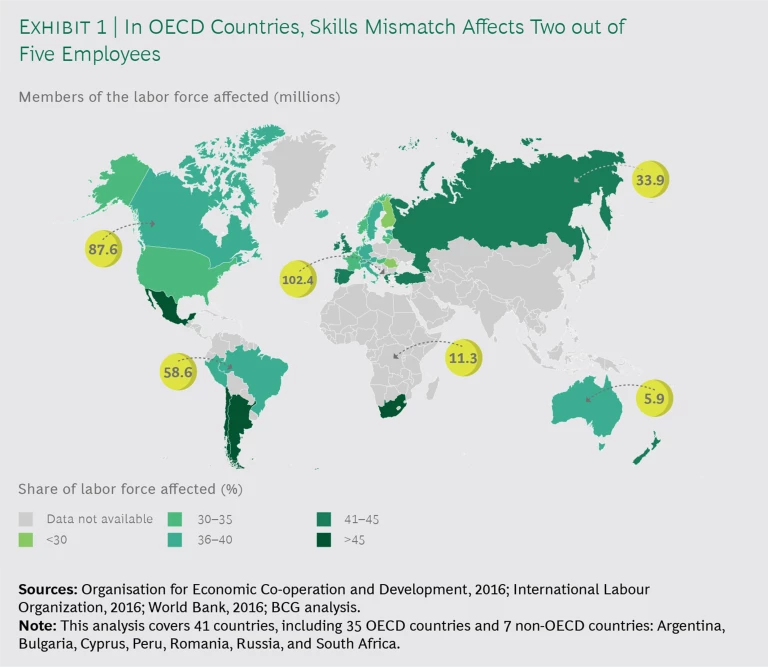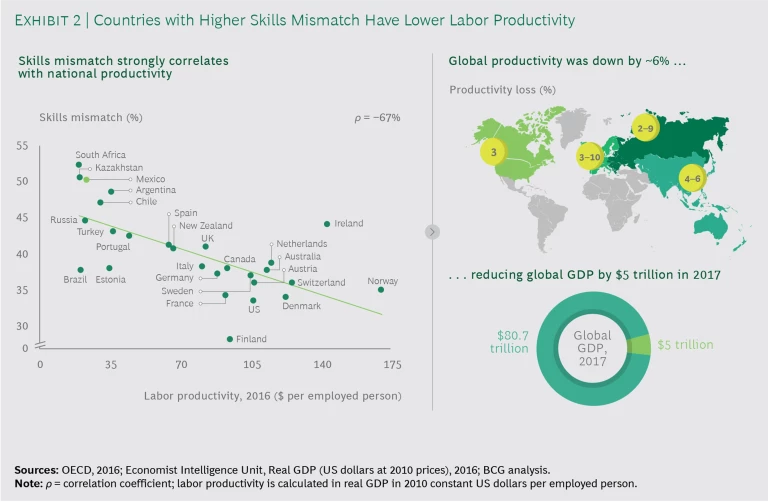Human capital is under intense pressure worldwide as powerful forces—globalization, demographic and regional shifts, digitization, urbanization, and virtual and informal forms of employment—gain momentum. These forces are changing how, where, and when people work, but we continue to base human-capital development on a mid-20th-century model: standardized education and one job for life. This cannot work in today’s world, which demands continuous-growth competition. Ongoing technological change and market transformations require flexible thinking, quick and continuous learning, and mobility. Instead of mass standardization, we need to embrace mass uniqueness and human centricity.
Human capital is not a homogeneous commodity. It includes baby boomers, who were born during the dawn of the space age; Generation Xers, who rode the wave of personal computing; millennials, who grew up with mobile phones; and Generation Zers, who are digital natives. Each group has distinctive interests, values, knowledge, skills, experiences, and ambitions. To participate in society and the economy, they need training, jobs, career paths, new ways of developing their professional lives, and retirement plans.
The “skills mismatch” is much less obvious than the skills gap, because it creates the illusion of employment and economic and social stability.
In our increasingly complex world, it’s not easy to unlock the full potential of each person. The problem is, in part, the result of ineffective—or nonexistent—communications between the private sector and education authorities: there are huge gaps between the goals of education systems and the needs of business. Unless they heed the insights of the private sector, education and skills development systems will continue to prepare people whose competencies will be outdated or in oversupply by the time they graduate, broadening a “qualifications trap.” Employers will struggle to hire the talent they require. Forced to take on people whose skills and experience fall short of what’s needed, employers will have to spend money on retraining. Meanwhile, those whose skills are not in demand will take any job simply to earn a living.
This problem, which we call the “skills mismatch,” is much less obvious than the skills gap, because it creates the illusion of employment and economic and social stability. Yet the economic and human toll of the skills mismatch is heavy. In Organisation for Economic Co-operation and Development (OECD) countries, the skills mismatch affects two out of five employees. (See Exhibit 1.) And according to our estimates, the skills mismatch affects 1.3 billion people worldwide and imposes a 6% annual tax on the global economy in the form of lost labor productivity.

The future economy demands a new approach. To realize the full potential of human capital and to fix the global skills mismatch, we must address seven challenges:
- We are insufficiently focused on training for jobs that have yet to appear. It is expected, that by 2022, 27% of available jobs will be in roles that don’t yet exist.
- Most members of the labor force are not involved in lifelong learning and continuous retraining. But skills are becoming obsolete at an increasingly fast rate—technical skills, for example, are outdated in two to five years—heightening the need for reskilling and upskilling.
- Many people lack motivation and accountability for personal development. Only 28% of respondents to a BCG survey reported that they consider using self-service content for learning.
- Access to labor market opportunities is limited. About 41% of job seekers find jobs through online platforms, 14% through social networks. Meanwhile, 3 billion people (mostly in Asia and Africa) lack access to the internet.
- Redistribution of human capital is uneven. In the US, 90% of job applications are for positions within 100 kilometers of the job seeker’s location; the pool of candidates increases by as much as 20% when the search region is expanded.
- The potential of certain labor categories is locked up. In the US, for example, working-age people with disabilities make up as much as 7% of the population, and only one-third of them work.
- The values and needs of the labor force are shifting. Generation Z is ready to accept 10% lower earnings to work fewer hours. Only 36% of that group consider career growth to be a major priority.
The future economy demands a human-centric approach. This approach must be used to help workers acquire fundamental skill sets and create an enabling environment for lifelong employability, self-realization, and skills liquidity in a labor market that offers accessible opportunities and is inclusive and focused on people.
At a time of high uncertainty, people need the cognitive and noncognitive skills and knowledge necessary for adapting to employers’ changing requirements. They need skills that the labor market will continue to demand. At the same time, to be able to choose a career path, and in order to fully unlock their potential, people must take responsibility for their own professional development.
For every potential employee, the government should ensure equal and open access to development and employment opportunities. Employers should pursue nondiscriminatory hiring on the basis of skills and competencies, taking into account the changing values of employees. The education system needs to find new approaches to the personalized training of future employees, considering their skills and knowledge, as well as employers’ continually changing requirements.
To unlock the full potential of human capital in the face of constant change, we need to shift from mass standardization to mass uniqueness, treating talent not as a consolidated economic resource but as sets of distinct personalities, each set with different needs, capabilities, and potential and each able to make a unique contribution to the economy and society.
To unlock the full potential of human capital in the face of constant change, we need to shift from mass standardization to mass uniqueness.
The Skills Mismatch: The Key Barrier to Human-Capital Development
A functioning and dynamic economy depends on the system that generates human capital. That system must supply sufficient numbers of people with the skills and knowledge needed to perform the tasks employers require. Today, as the innovation economy becomes dominant—new technologies and new ways of working demanding new skills and talents—the system is failing to meet labor market needs, leaving employers unable to find and employ sufficient numbers of qualified workers.
Commonly known as the skills gap—and facing every second employer—the problem is not the lack of potential employees. Rather, it is the mismatch between potential employees’ knowledge and skills and the tasks for which they are needed. Today, 1.3 billion people have competencies that either exceed or are insufficient for the activities they perform, and by 2030 there will be more than 1.4 billion.
The result is missed opportunities. For example, in 1970, fewer than 1% of US taxi drivers had a college degree. In 2013, the share of such “high-skilled taxi drivers” in the US had reached 15%.
A Hidden Productivity Tax and Social Risks. The skills mismatch is essentially a hidden tax and a qualifications trap. Underqualified employees are less productive, and, because they must be trained or retrained, they add to employers’ costs. The hidden tax takes effect also when companies have invested in skills and knowledge of employees and then don’t reassign them to the right jobs: the retrained employees remain unused for long periods of time, gradually lose their new skills and knowledge—and motivation. And keeping overqualified employees, many of whom require higher salaries, is not cost-effective: they cannot deploy their full potential in their assigned roles.
Nor is the skills mismatch purely a problem for employers. For employees, it causes uncertainty about income, employment prospects, and career development. This is exacerbated by news of mass layoffs, particularly as automation takes over tasks once handled by humans. Whether they are caused by production automation, emerging technologies, business model innovations, market shifts, or the closure of uncompetitive divisions, mass layoffs increase social tensions.
The skills mismatch is essentially a hidden tax and a qualifications trap.
The skills mismatch creates risks for governments too. Uneven economic growth and global divisions of labor lead to ever-greater disparities among the world’s economies.
Finally, the skills mismatch threatens global productivity growth. Evidence of this is already emerging. In 2016, OECD countries experienced an average decrease in labor productivity of 6%. A negative correlation between productivity and the skills mismatch explains the loss. (See Exhibit 2.)

The Skills Mismatch and the Education System. The transition to a knowledge economy demands a workforce with highly developed digital skills, as well as, for example, complex-problem-solving ability, adaptability, and communications know-how. Meanwhile, the number of professions is growing rapidly, many having emerged in the past 10 to 15 years, bringing deeper specialization and new, independent areas of knowledge. As a result, certain technical skills become obsolete in two to five years—faster than the average training period for a highly skilled professional.
Yet, the system for building human capital uses a 20th-century approach to training. This approach, which was driven by the needs of large-scale industrial production, demanded workers who would maintain work discipline, meet employers’ standardized requirements, and, generally, remain in the same job for life. Employers would “order” the required number of employees from the education system, which operated as an “employee factory,” producing job candidates with standardized education and defined sets of skills and knowledge.
The system remains largely unchanged, producing many workers who lack the skills the labor market demands and, therefore, experience a skills mismatch. Without changing its fundamental approach, the education system, aiming to adapt to new, more sophisticated market requirements, is becoming more complex and cumbersome, and courses of training take longer and cost more.
According to the College Board, a US not-for-profit organization that develops and administers tests and curricula, the cost of tuition and fees for a four-year college education has increased twofold to threefold, net of inflation, over the past 30 years. And according to research by Harvard University and Korea University, over the past 50 years, the average duration of studies has increased by factors of 1.9 and 3.6 in developed and developing economies, respectively.
Human Centricity: Transforming Education and Labor Markets
The 20th-century social contract, with its standardized education, nontransparent labor markets, job-for-life expectations, student work placements, and internships, makes it virtually impossible to overcome the skills mismatch. Creating the even distribution of human capital needed to solve the problem will require employees, the education system, employers, and government, to create a fundamentally new social contract, one that is informed by mass uniqueness.
This means creating conditions that allow workers to choose where and how to deploy their time and skills, as well as where to focus their training and development. It means providing workers with the skills and knowledge that will enable them to adapt to employers’ changing requirements. The actors in the system play various roles:
- Employees must take responsibility for their own professional development so that they can choose their career paths and unlock their full potential.
- The education system should act as a mediator among employers, the government, and individuals, providing potential employees and workers with a full toolkit for personalized lifelong training and offering new forms of training that take into account employers’ continually changing requirements.
- Employers should select employees on the basis of their skills and values and should provide opportunities for personal self-realization in the workplace. Employers should consider the values of individual workers to be a competitive advantage that underpins their personal and professional growth.
- Governments should guarantee everyone equal, open, and personalized access to development and employment opportunities.
The workers of the future must learn continuously in order to remain in demand, maintain their performance throughout ongoing technological change, and train for activities that do not yet exist. A human-centric approach helps workers of today start preparing for future challenges and permits all workers to acquire a fundamental skill set that includes communication, teamwork, problem-solving, planning, and learning abilities, enabling them to work in conditions of uncertainty and continual labor market shifts. For guaranteed lifelong employability, professional development should continue throughout each worker’s life and follow an individual path.
Meanwhile, the sources of individual motivation need to change. In the past, responsibility for an individual’s professional development was assigned to employers and the state. Today’s world demands employees who are motivated to take responsibility for their personal growth, in terms not only of learning but also their growth as individuals. Fostering this change will not be easy: BCG studies of employers have found that in 74% of countries, problems associated with employees’ self-realization and motivation are among the most challenging.
A human-centric approach helps workers of today start preparing for future challenges and permits all workers to acquire a fundamental skill set.
Yet the human-centric approach demands that employees should—consciously and independently—determine which skills they will learn, define the scope of knowledge they aim to acquire, and decide how much time they will spend on learning. The role of the government and employers is to provide support and ensure the broadest possible access to opportunities. This will require not only a shift in how education and training are funded, designed, and delivered but also a change of mindset.
Finally, to unlock human potential, the limits on access to opportunities in the labor market must be removed. These limits take many forms: lack of information about job vacancies, employer bias regarding applicants’ formal qualifications, and the unwillingness of employers to consider special personal circumstances and values when hiring. Such barriers make it more difficult for workers to achieve self-fulfillment and perform to the maximum and could lead them to seek opportunities in other industries or locations.
Collaborate or Pay
Using human centricity and mass uniqueness to prepare today’s labor market for the future will demand new ways of thinking and a collaborative approach as well as investments of time and money. As part of this, every country must design systems that ensure that its workforce skills and knowledge meet demand, support employee motivation for personal development, and open up labor market opportunities to all.
In addition to the development of human-centric tools and solutions, there must also be a shift toward greater collaboration among all stakeholders—employees, employers, education systems, and governments.
Collaboration will be needed not only within countries but also across borders. Growth rates of countries with open economies are almost three times the rates of those with closed economies. Countries that have open labor markets and are prepared to share best practices with their peers will be far better equipped to resolve labor market mismatches.
Countries should create a community of experts to lead global human-capital development and implement education and labor market solutions that foster a human-centric approach. This might include the development of a platform for exchanging ideas and best practices. Establishing such a community, as well as practical tools to support it, would accelerate the problem-solving process.
In a highly uncertain, rapidly changing world, countries cannot act alone. Those that try to erect borders will exacerbate the skills mismatch and will end up paying the productivity tax. But through collaboration and knowledge exchange—fostering a more open and international talent market—countries can secure the technological and human capital needed to create successful, equitable, and future-ready economies.






